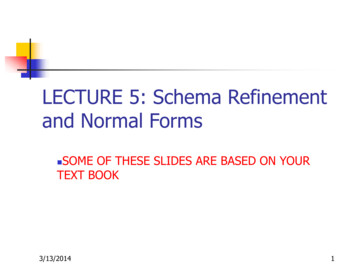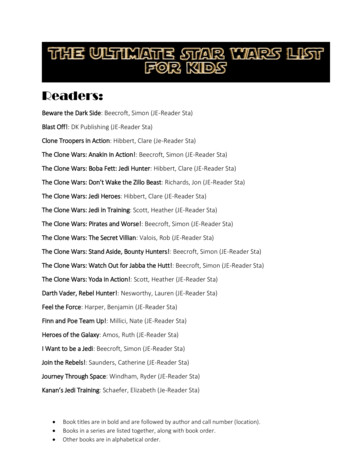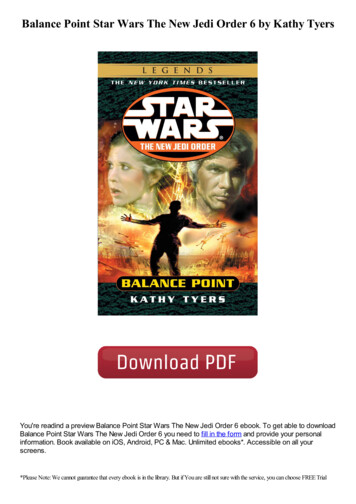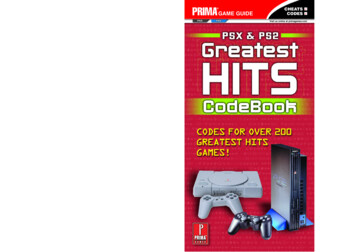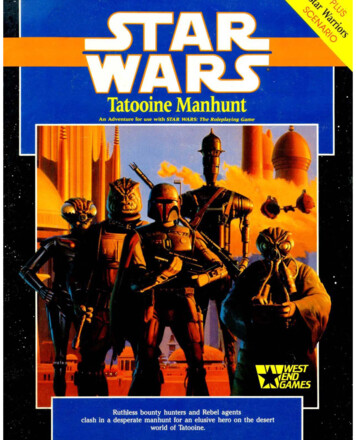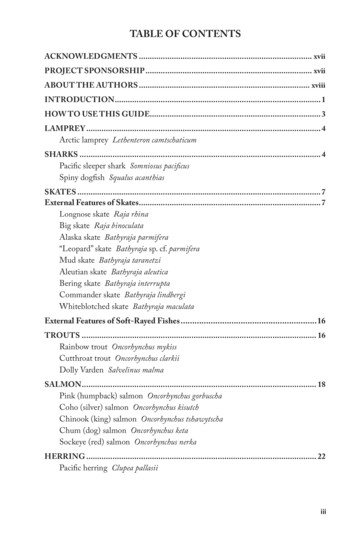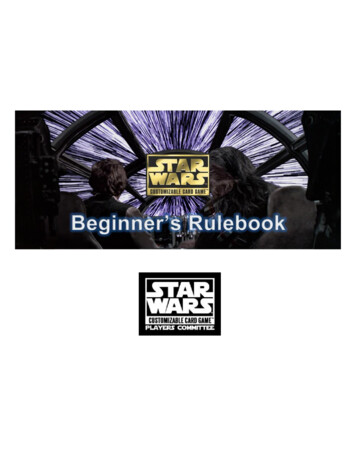
Transcription
Star Wars CCG – The Beginner’s Rulebook. This Beginner’s Rulebook contains everything you need to know to get started and play a basic game. Itis intended for new players who know little or nothing about how to play SWCCG. While the rules in this rulebook describe how the game is played, manycards in Star Wars CCG contradict or allow players to break the rules. Whenever a card contradicts any part of this rulebook, the card text takesprecedence.Basic Overview – Throughout the course of a game of SWCCG, two players (one Dark Side, one Light Side) place various locations on the table andbattle for control over those locations with major and minor characters from the Star Wars universe. Each turn, players make strategic decisions aboutwhich characters, vehicles, starships, and weapons they will deploy, and where to deploy them. Your 60-card game deck represents the amount of life(Force) available to you during the game. The basic unit of measurement in the game is 1 Force (1 unit of Force 1 card). When your opponent runs outof cards, you win the game!By controlling important locations, you can gradually deplete your opponent’s Life Force a little bit each turn. The more locations you control, the moreForce (cards) your opponent must lose. But if you spread your forces too thinly, you risk losing battles to your opponent. Losing a battle at a locationcould wipe out your forces there and/or cause you to lose large amounts of Force!The central area between the two players is called “the table”. This is where most of the action takes place – it’s where players place their locations,characters, and other cards. Separate from the table, directly in front of each player is that player’s Life Force, which consists of several piles of cards. Atthe start of the game, there are very few cards on the table and many cards in each player’s Life Force. As the game progresses, the players will drawcards and deploy them to the table in an effort to overpower their opponent, take control of locations, and ultimately win the game.Starting the GameChoose Your SideOne player must have a deck containing 60 Light Side cardswhich have a light grey color on the back of each card. The otherplayer must have a deck containing 60 Dark Side cards whichhave a dark grey color on the back of each card. New players canpractice with fewer cards, such as 40 per player, but officialgames use 60.Play Starting Cards1. Starting Effect – Each player may search through their deck for acard labeled “Starting Effect”, deploy it on the table, and follow theinstructions on that card. This step is optional and may beskipped by new players.2.Starting Location or Objective – Each player searches throughtheir deck. If the deck contains an Objective (a purple two-sidedcard), they must deploy it on the table 0-side up and follow theinstructions printed at the top of the card. If the player’s deck doesnot contain an Objective, which is common for new players,simply choose any one location card in your deck and deploy it onthe table. If both players select a different Starting Location,deploy them simultaneously. If both players select the sameStarting Location, they put them aside and both select a newStarting Location.3.Starting Interrupt – Each player may search through their deck fora card with the text “Starting Interrupt” and follow the instructionson that card. This step is optional and may be skipped by newplayers.Shuffle and Draw Opening HandEach player shuffles the remaining cards in their deck and thendraws the top 8 cards into their hand. The remaining cards formthat player’s Reserve Deck, which is placed face down directly infront of the player.Begin the Game!The Dark Side player goes first – it pays to be the bad guy.THE FLOW OF THE FORCE:Since the game revolves aroundplayers offensively and defensivelymanipulating their Life Force,understanding how the Force isrepresented and used is extremelyimportant. Your Life Force is like aflow of energy and during play, yourForce cards will circulate throughyour piles as shown in the diagram.Life ForceYour Life Force consists of yourReserve Deck, Force Pile and UsedPile. If these three piles are totallydepleted, you lose the game! Cardsin your Hand, on table or in the LostPile are not counted as part of yourLife Force.Reserve DeckAfter you have played your starting cards and drawn an opening hand,the remainder of your 60-card deck becomes your Reserve Deck andrepresents the total Force available to you. Throughout the game, cardswill flow from your Reserve Deck to your Force Pile to your Used Pileand back again to the bottom of your Reserve Deck.Force PileDuring your Activate phase, you will move some of your cards fromyour Reserve Deck to your Force Pile. Your Force Pile represents theamount of Force energy that is available for you to use to performvarious game actions. For example, during your turn, you will decidehow much Force to use to deploy cards (during your Deploy Phase),how much to draw into your hand (during your Draw Phase), and howmuch to save for future use.Used PileDeploying a card to the table often requires youto ‘use’ Force: cards from your Force Pile aremoved face down, one at a time, to your UsedPile to represent this expenditure. As the nameimplies, this temporary pile holds cards ‘used’during a turn. Sometimes cards are placed herefrom table or in other ways (such as Interrupts).Lost PileThis is a pile where lost cards are placed faceup. Usually cards are discarded to the Lost Pileas the result of battle or at any time theopponent causes you to lose Force. Thesecards are generally not available for the rest ofthe game, but you can use certain cards toretrieve them.HandAll cards held in a player’s hand. Each player’s hand usually starts with8 cards; thereafter, there are no limits to its size.Re-circulatingAct of placing your Used Pile (as a group) beneath your Reserve Deck.You re-circulate at the end of each player's turn. Re-circulated cardswill work their way back to the top of the Reserve Deck duringsubsequent turns to be activated again.Losing ForceWhenever you are required to “lose Force” you must discard theappropriate number of cards (one at a time) to your Lost Pile. You maychoose cards to be lost from your hand or from the top of your ReserveDeck, Force Pile, or Used Pile (or any combination of these).Retrieving ForceWhenever you are instructed to “retrieve Force”, move the appropriatenumber of cards (one at a time) from the top of your Lost Pile to the topof your Used Pile. If you are instructed to retrieve a specific card or aspecific type of card, you may search your entire Lost Pile for it.Not Sponsored or Endorsed by Lucasfilm and/or Decipher and/or Parker Brothers - More information:www.starwarsccg.org
Turns - Players alternate taking turns. Each turn consists of six phases in the following order.1.Activate – Count your Force icons on all locations on table (bluelightsaber icons for the Light Side; red lightsaber icons for theDark Side). Add 1 to represent your personal Force (the Forceyou generate yourself). The total represents the amount of Forceyou may activate this turn (move that number of cards one at atime from the top of your Reserve Deck to the top of your ForcePile). Do not look at the cards; they remain face down as youmove them. You do not have to activate all of the Force you areentitled to, although you will usually want to.2.Control –If you have total ability of 1 or more (from characters orother cards) at a location, then you occupy that location. If youoccupy a location and your opponent does not, then you alsocontrol that location.At each of location you control during this phase, you may initiatea Force drain for an amount equal to the opponent’s Force iconsat that location. Your opponent must lose one card for each Forcethat you drained. Your opponent may choose to lose those cardsfrom their hand and/or Life Force, and must place the lost cardsface up on their Lost Pile.Some cards provide a bonus to be added to a Force drain (forexample, a location might say “Force drain 1 here”). Add thisbonus to the total Force that must be lost by your opponent.3.Deploy – You may deploy cards from your hand to the table. Youmay deploy as many cards as you wish, one at a time, providedthat you can pay the necessary deploy cost.Locations have no deployment cost.Characters, vehicles and starships list their deploy cost in a smallwhite box in the lower left corner of the card. Use Force to pay thecost by moving the necessary number of cards, one at a time,from your Force Pile to your Used Pile. Then place the deployedcard where you want it on the table.A player may only deploy characters, vehicles, and starshipswhere they have at least one Force icon or presence - total abilityof 1 or more at a location. (A character whose lore indicates theyare a spy may deploy regardless of presence and Force icons.). Characters may deploy to sites, or aboard vehicles andstarships. Vehicles may deploy to exterior sites, or aboard starships. Capital Starships may deploy to system locations. Starfighters may deploy to system locations, docking baysites, or aboard capital starships. Weapons, Devices, and Effects deploy according to theirgame text.4.Battle – You may initiate a battle at each location that you andyour opponent both occupy. Battles usually result in one or bothplayers losing characters, vehicles, and/or starships from thelocation. A severely outmatched player may be required to loseForce as well. (See page 4 for more detail.)5.Move – A wide variety of movement is available to characters,vehicles, and starships. (See page 5 for detailed information onthe various types of movement.) Landspeed, docking bay transit,shuttling, hyperspeed, landing and taking off are mutuallyexclusive; each card may make only one of those moves per turn.Transferring, embarking and disembarking are unlimited and maybe performed any number of times per turn.6.Draw – You may take any number of cards from your Force pileinto your hand, one at a time. Once you are done, end your turnby recirculating (place your entire Used Pile under your ReserveDeck, and your opponent must do the same). Your opponent nowbegins their turn.THE TABLE:Not Sponsored or Endorsed by Lucasfilm and/or Decipher and/or Parker Brothers - More information:www.starwarsccg.org
Card Types:Character — Character cardsrepresent the individuals whoparticipated in the events of StarWars, such as Luke, Leia, Han,Vader, Chewbacca, etc. The iconsshown above represent (in order)Alien, Droid, Imperial, Rebel,Republic, and Sith characters.Characters primarily deploy, battle, and move at ground locations(called ‘sites’). However, they can also be used at space locations(called ‘systems’) by deploying or moving them aboard one of yourstarships, where they can serve as pilots, gunners, and more. Acharacter cannot exist at a system location unless aboard a starship.Characters are deployed during your Deploy Phase. To deploy acharacter from your hand to a location, you must use the appropriateamount of Force (called the ‘deploy cost’), shown in the white box in thelower left corner of the card.Device — Device cards represent useful tools and otherequipment. Examples include Luke’s bionic hand, Boba Fett’s Jetpack,and even the tractor beam aboard the Death Star. Devices aredeployed during your Deploy Phase. To deploy and use a Device,simply follow the instructions written in its game text. If no deploy cost islisted in the game text, the Device deploys for free. Each character,vehicle or starfighter may fire only one weapon and may use only onedevice per turn. (Capital starships may use any number of weaponsand devices per turn.)Effect — Effect cardsrepresent long-term alterations toother cards or aspects of thegame. For example, the Effect card“Lightsaber Proficiency” deploys ona single character and makes thatcharacter more powerful. “IncomCorporation”, deploys on a sitemakes all X-Wing starfighters inthe game more powerful.Effects are played during the Deploy Phase of your turn on the table oron characters, locations etc. An effect generally applies only to the sideof the table where it is played. If an Effect is canceled by another card,any modified conditions revert to their previous status. Place thecanceled Effect in the owner’s Lost Pile.Interrupt — Interrupt cardsrepresent a surprise or sudden turnof events. To play an Interrupt card,simply follow the instructions in thegame text. Unless specifiedotherwise, an Interrupt may beplayed during any phase, evenduring battle or during theopponent’s turn.If an Interrupt does not list a cost inits game text, it plays for free. There are two kinds of Interrupts: Usedand Lost. After you play it, a ‘used’ Interrupt is placed face down on topof your Used Pile; a ‘lost’ Interrupt is placed face up on top of your LostPile.Drawing Destiny:Drawing destiny represents the element of fate or chance involved inactions. Destiny draws sometimes have special labels such as “battledestiny” or “weapon destiny”, but all destiny draws are accomplished inthe same manner. If an action (such as firing a weapon) requires you todraw destiny, but your Reserve Deck is empty, the action simply fails(for example, the weapon would fail to hit its target).Location — There are primarilytwo types of locations used inSWCCG: sites (horizontallyorientated) represent locations onthe ground where characters andvehicles deploy, battle, and move,such as the Echo Base DockingBay. Systems (vertically oriented)represent major destinations inouter space where starshipsdeploy, battle and move, such asTatooine. Locations are vitallyimportant in that they provide theForce generation (the blue and redlightsaber icons) that each playerneeds to deploy other cards suchas characters, weapons, andstarships. A player who controls alocation is able to “Force drain”their opponent during their controlphase, causing the opponent tolose cards.Objectives — Objective cards represent long-term planning byproviding a player with specific starting cards, game play conditions,and short and long term rewards for completing tasks. A player mayonly include one Objective card in a deck, and if you choose to includeone, you must deploy it instead of a starting location at the beginning ofthe game. Objectives have game text on both sides of the card. AnObjective card always deploys with its front side (as indicated by thedestiny value of zero) face up.Starships— Starship cardsportray machines, such as StarDestroyers, used to travel andbattle in space. Starships primarilydeploy, battle, and move at systemlocations. Many Starships havecapacity to carry character cardsaboard as pilots or passengers.This capacity is described in theStarship’s game text.Vehicles — Vehicle cards portray machines like AT-ATs that battleand move on the ground. Vehicles deploy to exterior site locations. Avehicle must have a pilot (or driver) aboard to perform most of its gamerelated functions, such as moving orproviding power during a battle.Weapons — Weapon cardsrepresent the armaments utilized bycharacters, starships, vehicles oreven Death Stars during battle inorder to inflict damage againstopposing forces. You do not need aweapon to initiate a battle, but theycan provide advantages.Other Card Types — SWCCG contains anumber of other less commonly played card types, such as Creatures,Epic Events, Jedi Tests, and more. Consult the Intermediate RulesGuide for more information on these other types of cards.How to Draw Destiny1) Reveal the top card of your Reserve Deck. The number in thetop right corner is its destiny number; locations have a destinynumber of zero.2) Players may play any applicable responses (for example, thecard Han’s Dice causes a destiny to be canceled andredrawn); your opponent has the choice to respond first.3) Place the destiny on top of your Used Pile.Not Sponsored or Endorsed by Lucasfilm and/or Decipher and/or Parker Brothers - More information:www.starwarsccg.org
BattlingYou may initiate a battle at a location that both players occupy duringthe Battle Phase of your turn. By battling your opponent, you canattempt to eliminate his forces and take control of the location foryourself. You may battle more than once during a turn, but only onceper location. Each of your characters, vehicles and starships may battleonly once per turn, even if they somehow move to a new locationbetween battles. Other cards may be used in more than one battle perturn if applicable. Weapon cards are useful in battles, but they are notrequired.Initiate the BattleTo initiate a battle, use 1 Force and let your opponent know where youare battling them. Some cards state that they may be played when abattle has been “just initiated” or as a ‘react’. Such cards are played atthis time, however reacts are only allowed for the defender (see Reactson page 5). Since you initiated the battle, the opponent is allowed thefirst such response and then players alternate responses until bothplayers pass.Weapons SegmentDuring the Weapons Segment, players take turns firing weapons andusing other cards such as interrupts or devices beginning with theplayer who initiated the battle then alternating between the players.During the weapons segment, players may play interrupts and performother types of actions normally. This is not true of the upcoming Powerand Damage segments, where players must follow the steps of thosesegments strictly. The weapons segment ends once both players finishfiring weapons and playing other cards.Each weapon describes how it works, including the kinds of cards itmay target, the Force required to fire it, the destiny draw required forsuccess and, if successful, the consequences for the target. Generally,a weapon must be present with its target to be fired. For example,character weapons may not fire into or out of a starship (or a vehiclelabeled ‘enclosed’). Each weapon may only be fired once per battle,unless specified otherwise.Most weapons specify that they ‘hit’ their target when successful. Any‘hit’ cards are turned sideways, but they still participate in the battle. Forexample, a card that is ‘hit’ can still fire its own weapon, if it has one.Later on, during the damage segment, all ‘hit’ cards will be lost,regardless of who wins the battle.Power SegmentTo determine who wins the battle, add up the total power you haveparticipating in the battle; your opponent does likewise. If the battle istaking place at a system, add the power of each of your pilotedstarships; if at a site, add the power of each of your piloted vehicles andeach of your character cards except those inside starships andenclosed vehicles. Remember that ‘hit’ cards still count towards yourtotal power.Often you can increase your total power in a battle by drawing battledestiny. Each player who has a combined total ability of 4 or moreparticipating in the battle may make one destiny draw. To meet the 4ability requirement, you may count the ability of all of your cards in thatbattle, except for passengers who are inside starships or enclosedvehicles. Also note that having greater than 4 ability, does not entitleyou to make an additional battle destiny draws.The player who initiated battle draws their battle destiny first, and thenthe other player does the same (see Drawing Destinies on Page 3).Some cards instruct you to draw additional battle destinies, or to addadditional destinies to your total power or to attrition. All such destiniesare drawn during the Power Segment with power first, then battle andfinally attrition destinies. Your total power is increased by your power destinies andbattle destinies. If you drew any battle destinies, your attrition againstopponent is the total of your battle destinies and attritiondestinies. If you did not draw any battle destinies, the attritionagainst your opponent is 0 and cannot be increased (not evenby attrition destinies). Attrition is explained in the DamageSegment.The player with the higher total power (including destiny) wins thebattle. The other player loses, but both players may incur some lossesduring the Damage Segment.Damage SegmentIn this segment, players typically lose Force and/or forfeit cardsbecause of three factors: weapon hits, attrition and battle damage.Forfeiting is the act of losing cards from a battle to satisfy those threefactors. You may only forfeit cards that participated in the battle. Whena forfeited card leaves the table, it causes everything on that card to belost as well.Beginning with the player who initiated the battle, players alternatelosing Force / forfeiting cards to satisfy weapon hits, attrition and battledamage. Once you have forfeited all of your cards that were hit andsatisfied all your attrition and battle damage, you may not voluntarilyforfeit any additional cards. After both players have forfeited all hit cardsand have satisfied all attrition and battle damage, the battle ends. Cards hit during the weapons segment must be forfeitedduring the damage segment. However, this only means thattheir forfeiture is mandatory, not that they must be forfeitedfirst. Attrition represents inevitable losses in battle that occurregardless of who wins the battle. The attrition against youwas calculated during the power segment. This attritionagainst you requires a mandatory forfeiture of your cards fromthat battle location. If you have no cards left to forfeit, anyremaining attrition against you is ignored. Some cards areimmune to a certain amount of attrition. This immunity ischecked at the beginning of the damage segment and onlythen. All pilots and passengers share the immunity of thevehicle or starship they are aboard. Unlike weapon hits and attrition, battle damage applies onlyto the player who lost the battle. The loser‘s battle damage isequal to the difference between the winner‘s total power andthe loser‘s total power. You may satisfy battle damage byforfeiting cards from the battle. Unlike weapon hits andattrition, battle damage may also be satisfied by losing Forcefrom your hand and/or Life Force. Each card lost satisfies 1unit of battle damage. You may select which cards to losefrom your hand, but if you wish to lose cards from your LifeForce they must come from the top of your Force Pile, UsedPile and/or Reserve Deck. To satisfy your battle damage, youmay use any combination of forfeiture and losing Force.It is critical to note that forfeiting a single card satisfies bothattrition and battle damage, even if it is ‘hit’.Not Sponsored or Endorsed by Lucasfilm and/or Decipher and/or Parker Brothers - More information:www.starwarsccg.org
SPECIFIC RULESConverting Locations — Many locations have both a Light Side and aDark Side version. Only one of each unique ( ) location may be in playat a time. A location on table can be converted by deploying theopposing side’s version on top.Movement – Shuttling - A character or vehicle may be shuttled (by thesymbolic use of dedicated shuttles, which are assumed to be aboardevery capital starship) from an exterior site to a capital starship at therelated system (or vice versa) for 1 Force. Shuttling is not allowed to orfrom a starfighter.Location DeploymentSite locations may deploy even when their system isn't on table, andvice versa. For example, the Tatooine Cantina may be deployed even ifthe Tatooine system location is not on the table.Locations on the table must always be grouped together by system.The figure at the bottom of Page 2 of this guide shows three Tatooinelocations (two sites, plus the system) grouped together, as well as oneDeath Star site which is physically separated off to the side. This helpsto make it more obvious that a character such as Boba Fett cannotsimply walk from the Death Star site to a Tatooine site.Every site has an interior icon , an exterior icon , or both. Whenmultiple sites have been deployed to the same system, all interior sitesshould be grouped together, all exterior sites should be groupedtogether, and all sites with both icons should be placed between thosetwo groups.When a new site is deployed to an existing group of sites, it may beinserted between or placed at the end of the related sites. Oncedeployed, locations may not be rearranged.Movement – Transferring - Any number of characters and vehiclesmay be transferred (by the symbolic docking of two starships or use ofdedicated shuttles) from one starship to another at the same system for1 Force if at least one of those starships is piloted and has ship-dockingcapability, or is a capital starship.Movement - Docking bay transit — You may relocate any or all ofyour characters and vehicles as a group from one docking bay toanother docking bay (by the symbolic use of independent starships forhire) for an expenditure of Force as listed on the docking bay card.Movement - Embarking and disembarking — Your characters at asite may embark on or disembark from your vehicle (or landed starship)at that same site, capacity permitting. Similarly, starfighters mayembark on and disembark from a capital starship at the same system.Movement - Hyperspeed — A piloted starship may use 1 Force tomove from one system to another system. The starship’s hyperspeedindicates the maximum distance the starship may travel, measured inparsecs (1 parsec 1 unit of hyperspeed). The parsec distancebetween two systems is determined by subtracting the lower parsecnumber from the higher. (It is not necessary for the parsec numbers “inbetween” to be on table; for example, a starship with hyperspeed of 3may move from a planet at parsec 5 to a planet at parsec 8, even if nosystems with parsec numbers 6 and 7 happen to be on table.)Movement - Landspeed — Each character or vehicle may use 1 Forceto move from one site to another related site. A card’s landspeedindicates the maximum distance it may travel, measured in sites (1 site 1 unit of landspeed). Characters have landspeed of 1. Vehicles havelandspeed as indicated on the card, but must have a driver or pilotaboard to move. Vehicles move only to exterior sites, but they can carryany number of characters (capacity permitting) for that use of 1 Force.Occupants of Vehicles and Starships — Characters aboard a vehicleor starship fall into three categories: pilots, drivers and passengers.Indicate which characters are aboard a vehicle or starship by placingthem underneath that card. You may designate which characters areacting as pilots or drivers at any time during your deploy phase or movephase. Pilots — A starship, combat vehicle or shuttle vehicle must bepiloted (by a character pilot or a permanent pilot) to move orto use its power or maneuver. Any pilots aboard a starship orvehicle in excess of its pilot capacity are passengers and thusdo not pilot the starship or vehicle. Drivers — A transport vehicle must have a driver aboard tomove or to use its power or maneuver. Typically, the drivermust be a character with ability. If more than one character isaboard, you must designate which one is driving. Passengers — Passengers are any characters aboard astarship or vehicle who are not acting as a pilot or driver ofthat starship or vehicle. Passengers do not contribute theirability towards drawing battle destiny (see “Power Segment”on Page 4). The passengers aboard a creature vehicle aresometimes referred to as ‘riders.’React — This is a special form of deployment or movement, granted bycards that say ‘react’ in their gametext, that may occur during youropponent’s turn (at normal use of the Force). A react occurs just afteryour opponent initiates a battle or Force drain and is initiated by saying:“React!”Reacting to a Force drain cancels the Force drain if you bring presenceto the location. All cards involved in a react are prevented from beinginvolved in another react during the same turn (even the first react wascanceled). If a card is allowed to move as a react, it is only permitted tomove using its landspeed, embarking/disembarking, or (in the case ofstarfighters) landing/taking off.Unique/Restricted — If the name on a card is preceded by a dot ( ),this indicates that it is a unique card. Although you are free to placemore than one unique card of the same title in your deck, you cannothave more than one face up on the table at any time during the game. Ifcards have two ( ) or three ( ) dots, the number of identical cards ofthe same title that can be on the table at the same time is restricted tothe number of dots on the card. When there are no dots preceding acard name, there are no restrictions on the number of these cards youcan have on the table. Note: An interrupt card with one dot ( ) indicatesthat only one interrupt of that name may be played per turn. If bothplayers have a unique ( ) card with the same name, only one copy ofthat card may be on the table at a time. It doesn’t matter that one is aDark Side card and one is a Light Side card.Uniqueness also extends further to cover personas. For example,“Lord Vader” and “Darth Vader, Dark Lord Of The Sith” are nottechnically the same card title, but they both represent the persona ofVader and thus the Dark Side player cannot have both on the table atthe same time.Movement – Landing and taking off - A piloted starfighter at a sitemay take off to the related system. Similarly, a piloted starfighter at asystem location may land at any related exterior site (TIEs, however,may only land at docking bays). Landing or taking off requires 1 Force,but is free to/from a docking bay. A landed starfighter has nolandspeed, power or maneuver. It may not utilize game text (exceptgame text relating to occupant capacity or permanent pilots), normalstarship weapons or any cards which would logically require thestarfighter to be moving.Not Sponsored or Endorsed by Lucasfilm and/or Decipher and/or Parker Brothers - More information:www.starwarsccg.org
Whenever a card contradicts any part of this rulebook, the card text takes precedence. Basic Overview - Throughout the course of a game of SWCCG, two players (one Dark Side, one Light Side) place various locations on the table and battle for control over those locations with major and minor characters from the Star Wars universe.




